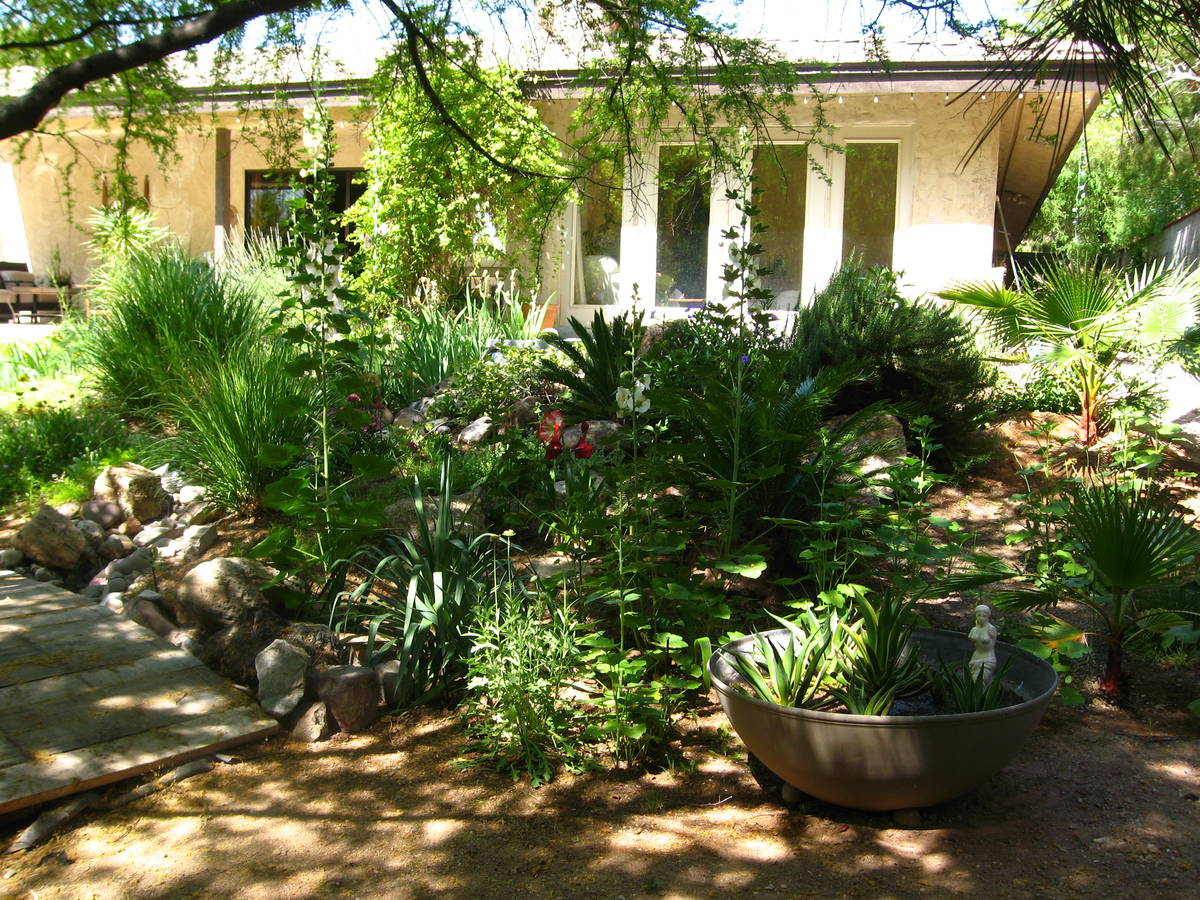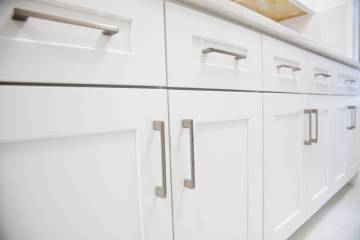House, landscape create microclimate in yard
Microclimates are created by every landscape that is created and house built. As soon as the house is built the microclimate of its landscape is created. The landscape enhances this created microclimate. How the landscape is created can enhance or distract from this microclimate.
In a very general sense, the south and west sides of a home or wall are warmer than north and east exposures. The two microclimate characteristics I focus on are altering temperatures during different seasons and changing the wind speed.
Some microclimates are more pronounced than others. Alter the microclimate of your landscape by changing the wind speed that enters and travels through your property.
Screens are more effective at altering wind speed than solid walls. This is because walls divert the wind causing turbulence while screens slow windspeed creating less turbulence, This slowing of the wind will impact landscape temperatures.
The most effective windscreens are about 80 percent solid. A good example to demonstrate this is a chain-link fence with its gaps filled with PVC slats. Windscreens also play an artificial role in slowing wind speed. Reed mats tied to an open fence can also work.
Plants can also slow wind speed, but plants need water (perhaps not so desirable in the desert) and should keep their leaves 12 months of the year (effective evergreen plants are hard to find in our climate).
Wind enters the property at different places but usually these places are gaps that funnel the wind or channel it from the street. Streets are like urban canyons. After you have lived in your home a few years you know the wind problem areas that should be addressed if you want warmer winter landscape temperatures.
Windscreens are effective to a distance of five times their height. If the objective is to alter the wind speed of a raised bed 10 feet long and constructed next to it, then a windscreen needs to be at least 2 feet tall. If the objective is to alter the wind speed in a sitting area, then the windscreen needs to be five times the height of the sitting area plus the distance from it.
Q: Our microclimate must be interesting since we have very productive Meyer lemons, red grapefruit, Santa Rosa plums, and a huge silk tree.
A: When you mentioned these plants, my mind flashes to the minimum freeze tolerance, about 22 degrees Fahrenheit for short periods of time for the most tender in the group. There are two basic weather characteristics to address when identifying your landscape microclimate: temperature and wind.
If areas are windy, plant survivability at these lower temperatures is affected. Meyer lemon and grapefruit are two citrus trees commonly recommended for backyard planting in our climate and soils. Why? Because for most microclimates these citrus types are a good choice.
Other citrus is riskier. The other plants you mentioned are even more cold-tolerant than the citrus.
South and west-facing parts of the landscape are usually warmer than the north and east-facing microclimates. This warmth can be blown away by strong winds. So, constructing or planting a wind barrier for these areas creates a warmer microclimate by a few degrees.
There are areas in Las Vegas that can provide an even warmer microclimate, 28 degrees, during the winter for short periods of time. The overall climate in these areas is typically warmer than most of the valley. These landscapes are more likely to successfully grow citruses like limes, navel and blood oranges, which can’t handle the freezing temperatures of Meyer lemon and grapefruit.
Planting those plants less tolerant of our freezing temperatures during Las Vegas’ normal winter is better than placing a bet at the craps table; most often you will win but sometimes you lose. This past winter, for instance, was considered a warm winter because most of the Las Vegas Valley received no freezing temperatures.
This winter we won the winter freezing bet. Next winter we might not.
Q: I planted an olive tree, and it just isn’t growing like the other I planted at the same time. It is getting watered three times a week for about one hour via its three to four emitters. These plants are surrounded by woodchips on the soil surface. Plus, I am watering the tree with a shower of water once a week to remove salts from the soil.
A: This time of year, the third week of February, it’s normal to water trees deeply only once a week, even when newly planted. At the most, you might justify twice a week.
After planting, water daily for a couple of days to settle the soil around the roots and then switch to less frequent watering. Watering three times a week is more like the watering frequency needed in May.
I didn’t like it when you mentioned three to four emitters. The difference of one drip emitter can be one-fourth of its applied water. That is huge in the desert. Please be more precise in your watering efforts.
When watering, trees get more applied water than a 3- to 4-foot-tall flowering shrub. That’s because the roots of trees grow deeper than smaller shrubs.
Trees and shrubs that grow more than 15 feet tall are watered 18 inches deep. Shrubs smaller than this are only watered 12 inches deep. The soil depth that becomes wet after an irrigation is tied directly to the number of emitters, their gallonage and distances apart.
Pull the wood-chip mulch away from tree trunks 6 to 12 inches. Because you are watering often, it’s possible to promote a disease called collar rot that is common to many woody plants.
In cool weather like now, this disease can cause trees to struggle in their growth. In hot weather, the same tree dies quickly from this disease because collar rot basically strangles it faster.
This same disease occurs when trees are planted too deep. Always plant trees and shrubs at the same depth they were growing in the nursery container. Make sure the one struggling was not planted deeper than the other. When others plant it, I do this by wiggling the plant back and forth before it’s staked and watch the soil move.
The second issue is fertilizing trees and shrubs. Most trees and shrubs need, at most, a fertilizer applied once each spring. But fresh wood chips can rob the tree of fertilizer it needs for growth. Make sure young trees and shrubs, planted with fresh wood chips around them, are fertilized in the spring every year until both are older.
Q: What is safe to transplant now? I saw something at the nursery that I’d like to plant in the ground.
A: I love weather apps on my phone for gardening. They are pretty accurate for projecting what the weather will be for about two weeks.
Plant all winter-hardy plants now or even sooner. That’s a no-brainer. They can handle nearly all freezing temperatures during the winter.
If the plants are tropical (e.g., neem, moringa, papaya, bougainvillea, tomato, etc.) or subtropical (e.g., citrus, avocado, most bamboo, lantana, etc.), then air and soil temperatures are important. This time of year, the future weather tells you when it is safe to plant. Check the weather now and, also, for the next two weeks before planting winter tender plants.
The more tropical the plant, the longer I delay planting a few weeks in the spring. If there is no danger from freezing air temperatures, this is because of the cold soil temperature.
Their roots grow best when soil temperatures are warmer; for example, in tomatoes and papaya, 60 to 65 F is the minimum temperature for good growth. To get good root growth when it is cold, till the soil or cover it in clear plastic to warm the soil.
For subtropical plants like citrus temperatures closer to 65 to 70 F are best. Still, warm soil temperatures are needed for good root growth. But hardy winter plants like many cold hardy palms start root growth from 45 to 50 F.
So, remember, when planting tropical and subtropical plants, warmer soil temperatures are needed more than when planting cold-tolerant plants. Delay planting in the spring until you know reezing temperatures are finished and the soil has had a chance to warm up.
Bob Morris is a horticulture expert and professor emeritus of the University of Nevada, Las Vegas. Visit his blog at xtremehorticulture.blogspot.com. Send questions to Extremehort@aol.com.























